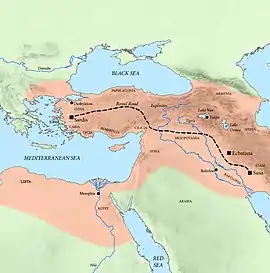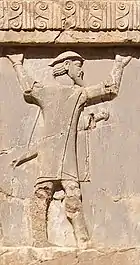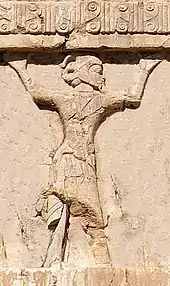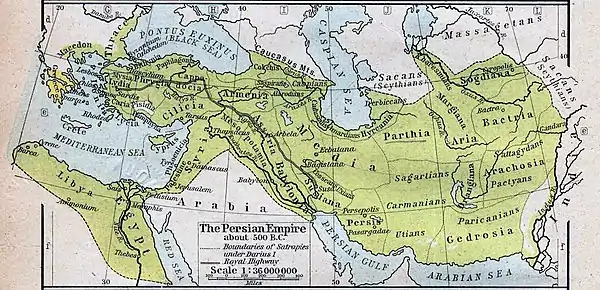Skudra
Skudra or Scudra (Greek: Σκύδρα) was a province (satrapy) of the Persian Empire in Europe between 510s BC and 479 BC. Its name is attested in Persian and Egyptian inscriptions (an Egyptian record of c. 498–497 BC, and a list on the tomb of Darius the Great at Naqsh-e Rustam, c. 486 BC.[1]). It is believed to have comprised the lands now known as Thrace and Macedon.[2]

N. G. L. Hammond hypothesizes that the name Skudra may have been the name originally used for this region by the Phrygians, who had settled in the area before migrating to Asia,[3] while Oswald Szemerényi derives it from a Scythian endonym *Skuda.[4]
The Thracian and Scythian regions were conquered by Darius I around 512 BC, the Macedonian kingdom by Mardonius in 492 BC. The latter had been a vassal of Persia since 512/511 BC, but remained having a large amount of autonomy.[5] The 492 BC campaign led by Mardonius made it a fully subordinate part of the empire.
Persian sources describe the province as being populated by three groups: the Saka Paradraya ("Saka beyond the sea", the Persian term for all Scythian peoples to the north of the Caspian and Black Seas [6][7]); the Skudra themselves (most likely the Thracian tribes), and Yauna Takabara. The latter term, which translates as "Ionians with shield-like hats", is believed to refer to Macedonians.[1]
The three ethnicities (Saka, Macedonian, Thracian) enrolled in the Achaemenid army, as shown in the Imperial tomb reliefs of Naqsh-e Rostam, and participated in the Second Persian invasion of Greece on the Achaemenid side. Only did the final defeat of the Achaemenids in the campaign free them from Persian control in 479 BC.
Notes
- Hammond, N. G. L. "The organization and the influence of Persian power in Europe". The Cambridge Ancient History: Persia, Greece and the Western Mediterranean c. 525 to 479 B.C. Cambridge University Press. pp. 246–253.
- "Achaemenid Satrapies" retrieved July 2015
- The Cambridge Ancient History, Volume 4: Persia, Greece and the Western Mediterranean, c.525 to 479 BC by John Boardman, D. M. Lewis, M. Ostwald, and N. G. L. Hammond, ISBN 0-521-22804-2, 1988, page 246 "The name 'Skudra' was probably Phrygian for the homeland, later called Thrace, which the Phrygians had left in migrating to Asia."
- Szemerényi 1980, p. 23-25
- Joseph Roisman,Ian Worthington. "A companion to Ancient Macedonia" John Wiley & Sons, 2011. ISBN 144435163X pp 343-345
- J. M. Cook (6 June 1985). "The Rise of the Achaemenids and Establishment of Their Empire". In Ilya Gershevitch (ed.). The Cambridge History of Iran, Volume 2. Cambridge University Press; Reissue edition. pp. 253–255. ISBN 978-0521200912.
- M. A. Dandamayev (1999). History of Civilizations of Central Asia Volume II: The development of sedentary and nomadic civilizations: 700 BC to AD 250. UNESCO. pp. 44–46. ISBN 978-8120815407.



